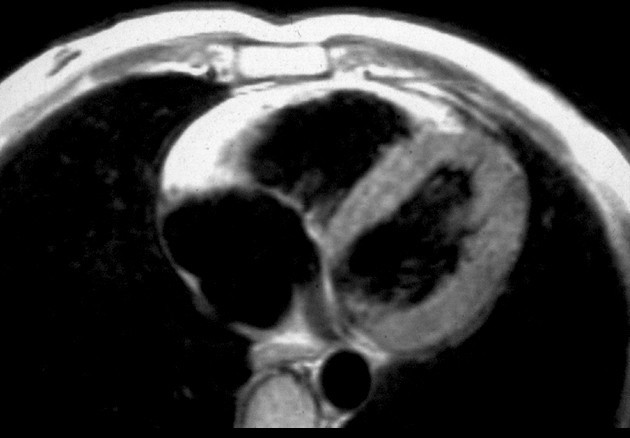Arrhythmogenic right ventricular dysplasia cardiac MRI
|
Arrhythmogenic right ventricular dysplasia Microchapters |
|
Differentiating Arrhythmogenic right ventricular dysplasia from other Diseases |
|---|
|
Diagnosis |
|
Treatment |
|
Arrhythmogenic right ventricular dysplasia cardiac MRI On the Web |
|
American Roentgen Ray Society Images of Arrhythmogenic right ventricular dysplasia cardiac MRI |
|
FDA on Arrhythmogenic right ventricular dysplasia cardiac MRI |
|
CDC on Arrhythmogenic right ventricular dysplasia cardiac MRI |
|
Arrhythmogenic right ventricular dysplasia cardiac MRI in the news |
|
Blogs onArrhythmogenic right ventricular dysplasia cardiac MRI |
|
Directions to Hospitals Treating Arrhythmogenic right ventricular dysplasia |
|
Risk calculators and risk factors for Arrhythmogenic right ventricular dysplasia cardiac MRI |
Editor-In-Chief: C. Michael Gibson, M.S., M.D. [1]
Overview
Among all the imaging modalities, MRI may be the most useful establishing the diagnosis of ARVD.
ACC/AHA Guidelines- ACCF/ACR/AHA/NASCI/SCMR 2010 Expert Consensus Document on Cardiovascular Magnetic Resonance[1] (DO NOT EDIT)
| “ |
CMR may be used for assessment of patients with LV dysfunction or hypertrophy or suspected forms of cardiac injury not related to ischemic heart disease. When the diagnosis is unclear, CMR may be considered to identify the etiology of cardiac dysfunction in patients presenting with heart failure, including
|
” |
Fatty Infiltration
Among patients with ARVD, fatty infiltration of the RV free wall may be visible on cardiac MRI as a bright area of hyperenhancement. Fat has increased intensity in T1-weighted images which can be either focal or diffuse. However, the fat may be difficult to differentiate intramyocardial fat and the epicardial fat that is commonly seen adjacent to the normal heart. Also, the sub-tricuspid region may be difficult to distinguish from the atrioventricular sulcus, which is rich in fat.
Thinning of the RV Myocardium
Cardiac MRI can visualize the extreme thinning and akinesis of the RV free wall. However, the normal RV free wall may only be about 3 mm thick, rendering the test less sensitive.
RV Dilation and Regional Wall Motion Abnormalities of the RV
RV dilation and regional wall motion abnormalities in the RV may be present.
Indications for MRI
- Family history of ARVD or sudden cardiac death
- History of syncope, palpitations, with abnormalities of the right ventricle on echocardiography
- Ventricular tachycardia, particularly a right ventricular outflow tract tachycardia with a left bundle branch block appearance
- Arrhythmias in a young athlete
MRI Examples
Shown below is the MRI of a patient with ARVD. This is a long axis view of the right ventricle. Note the transmural diffuse bright signal in the RV free wall on spin echo T1 due to massive myocardial atrophy with fatty replacement.

Shown below is the same image with the area of fatty deposition outlined in red:

References
- ↑ American College of Cardiology Foundation Task Force on Expert Consensus Documents. Hundley WG, Bluemke DA, Finn JP, Flamm SD, Fogel MA; et al. (2010). "ACCF/ACR/AHA/NASCI/SCMR 2010 expert consensus document on cardiovascular magnetic resonance: a report of the American College of Cardiology Foundation Task Force on Expert Consensus Documents". Circulation. 121 (22): 2462–508. doi:10.1161/CIR.0b013e3181d44a8f. PMC 3034132. PMID 20479157.